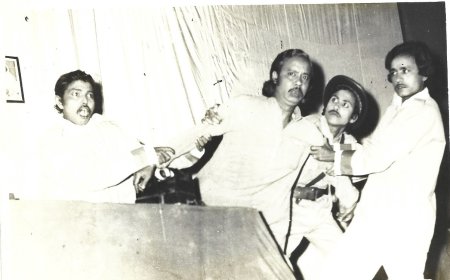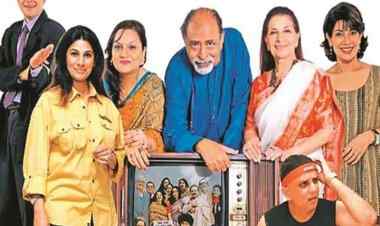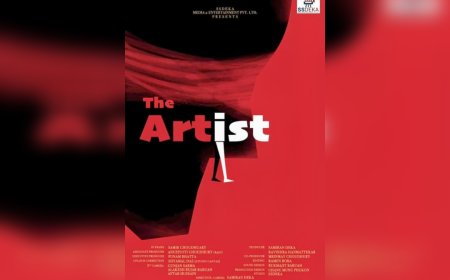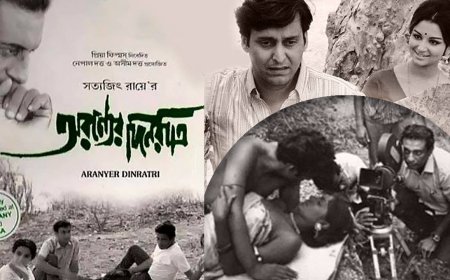WAHEEDA REHMAN BESTOWED THE DADASAHEB PHALKE AWARD A A LOOK-BACK AT PYAASA, KAAGAZ KE PHOOL AND GUIDE
Esteemed film critic, Dr. Shoma A. Chatterji pens an article paying homage to the illustrious WAHEEDA REHMAN, who has been rightfully honoured with the prestigious DADASAHEB PHALKE award, a recognition long overdue. Shoma A. Chatterji has meticulously conducted an in-depth examination of her artistic contributions in three seminal cinematic endeavours - PYAASA, KAAGAZ KE PHOOL, and GUIDE.
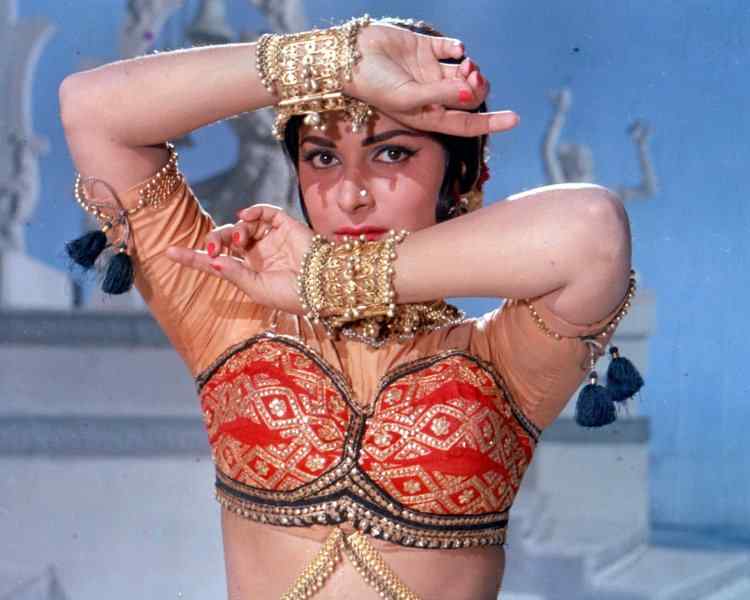
The Dadasaheb Phalke Award bestowed on Waheeda Rehman this year is long overdue. And because it is long overdue, it comes as a very pleasant surprise for those who have followed her career very closely, not just as a leading lady but also as a character actress in her senior years such as the brilliant performance as Daiji in Yash Chopra’s film Lamhe as the elderly governess who brings up the character played by Anil Kapoor in the film.
In this tribute, the writer, who has never had the good fortune of interviewing this great dancer-actress, will focus on three of her outstanding memorable performances in Pyaasa, Kaagaz Ke Phool and Guide. It is truly strange to discover that she won the National Award for her earliest roles in Sunil Dutt’s Reshma Aur Shera though everyone will agree that she ought to have bagged the same award also for Guide directed by Vijay Anand. She also performed brilliantly in a subtle role in Satyajit Ray’s Abhijaan as a young, dehati woman who is rescued from being trafficked by the hero played by Soumitra Chatterjee. She also portrayed a dowager’s role in Aparna Sen’s 6, Park Avenue but the film did not do well and died a silent death.
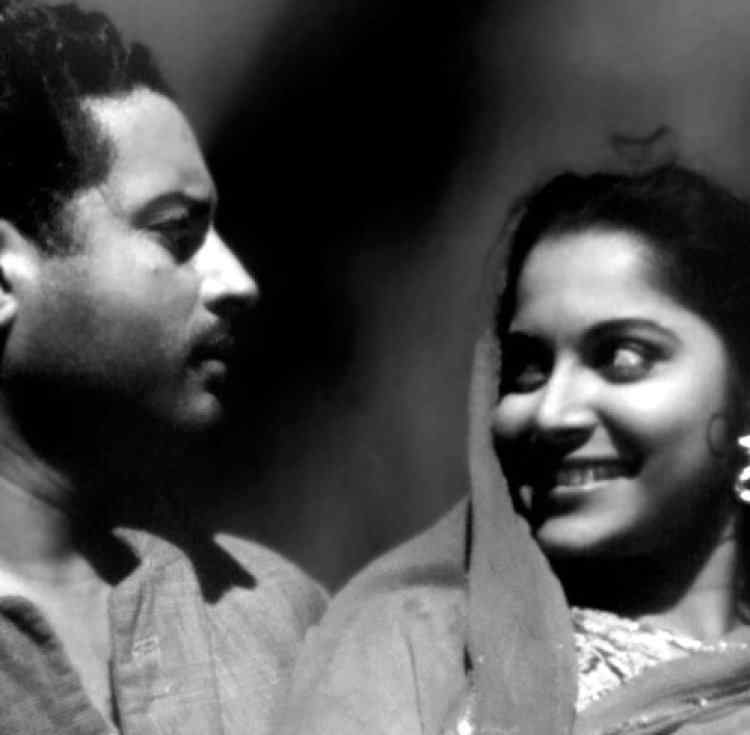
Image: Waheeda Rehman with Guru Dutta in Pyaasa
Gulabo of Pyaasa (1957) is perhaps the most restrained and dignified prostitute in the history of Indian cinema. Her dignity is subtle and underplayed probably because she is very poor. Her love for the poet Vijay (Guru Dutt) is rooted in the fact that when they meet for the first time, both share common social and physical space – the fringes of civil society and the margins of poverty. The irony of her character is that she loves poetry and at a point of time, even decides to publish Vijay's poems at her own expense in the form of a book. She buys the file of Vijay's poems his brothers had sold off to a shop trading in old newspapers. She approaches Meena (Mala Sinha), Vijay's old flame now married to a very successful publisher, with a request to get the poems published. When Meena tries to buy them off, she gracefully declines, quietly ignoring the cruel barb Meena makes hinting at her profession.
When counter pointed against Gulabo however, Vijay comes across as selfish and self-centred. Till the very end, he remains unaware of Gulabo's secret yearning and love for him. It is only after the bourgeois society rejects him completely that he realizes that the only person who can offer him true and selfless love is Gulabo who is a social outcast, an outsider by virtue of the fact that she inhabits a world where her means of survival is to sell sex beyond the borders of the very bourgeois society that has rejected him.
The fact that Vijay's roots lie within the framework of so-called middle-class respectability does not intrude into the undercurrents of bonding that draw them close on emotional terms, though Vijay realizes her worth only at the end of the film. When counter pointed against Gulabo however, Vijay comes across as selfish and self-centred. Till the very end, he remains unaware of Gulabo's secret yearning and love for him. It is only after the bourgeois society rejects him completely that he realizes that the only person who can offer him true and selfless love is Gulabo who is a social outcast, an outsider by virtue of the fact that she inhabits a world where her means of survival is to sell sex beyond the borders of the very bourgeois society that has rejected him.
Gulabo's waiting for her ideal man Vijay lasts throughout the film. As a whore, she is forever standing at a door or window waiting for her next customer. This 'waiting' is double layered because the physical waiting for the paying customer is also an emotional waiting for the man she has fallen in love with. She cannot reject the one for the other because she does not know when he will come, or whether or not he will come at all. Her patience pays off finally because he does arrive and ask her to accompany him to a place from where they will not need to go any further.' If one strips the layers of a self-imposed martyrdom off Vijay, the central character, and turns one's attention towards Gulabo, then, it is Gulabo who comes across as the stronger, the more sacrificing, the more loving and the more self-respecting of the two. In other words, she is a better human being than all the other characters put together, including Vijay.
Shanti of Kaagaz Ke Phool (1959) focusses on Suresh Sinha, a director of films. Three women of different ages and from different backgrounds mark his life. One of them is his wife Bina (Veena), another is his growing daughter Pammi (Naaz) and the third is Shanti (Waheeda Rehman), the woman he introduced to films and who later became a famous star. Suresh is estranged from Bina when the film opens. His rights to visit his daughter at boarding school are also withdrawn. Later, Suresh meets Shanti, an orphan, and by a strange quirk of fate, introduces her to films. They fall in love but never get to express their love for each other. When Pammi learns about the 'affair' through the gossip glossies, she persuades Shanti to leave her father alone and tries to reunite her estranged parents, in vain. Shanti goes away and Suresh finds himself sucked into a loneliness and alienation of his own making.
The three women play three different roles in his life. The wife and the daughter affect him negatively even with their physical absence from his life. It is Shanti who functions as the sacrificing woman who falls desperately in love with him but fails to rescue him from a tragic death. Suresh is in love with Shanti the actress and not Shanti the woman. Taking his relationships with the two other women in his life, can one conclude that having lived within the synthetic world of make-believe, he is incapable of loving a normal woman any more? Does he love Shanti as an actress because it allows him to command her life, to control her actions in any which way he desires? Even with these manipulations, he sticks to the characters she plays in his films rather than to Shanti as a woman per se. As Darius Cooper rightly comments: "When Shanti wants to step out of her characters and approach Suresh as a woman, she interferes not only with the process of sublimation but also disturbs the process of identification. Hence his need to avoid any physical contact with her."[i] Her need to touch him in some way is conveyed by what later evolves into a manic obsession for knitting sweaters that he will never wear. Yet, she hopes to embrace him vicariously if only in wool.
The most telling metaphor in Kaagaz Ke Phool is the act of knitting sweaters that Shanti indulges in. It is introduced as an innocent time-filler when she begins knitting on the sets during breaks in the shooting. Later, when Pammi's insults force her to retreat into the village and turn into recluse from films and fame, Shanti presents Suresh with a sweater, the only one she could manage to give him. Years later, during the shooting of a film, as the female lead, in a scene she is supposed to do with a bit player, Shanti recognizes Suresh who steps in as the bit player from the sweater he is wearing when he removes his costume. It is full of holes now, but he still wears it, almost like a second skin. We last see Shanti as a doomed Penelope figure obsessively knitting sweaters for her Odysseus who will never return to claim them or exchange them for the one with the holes. Her cupboard is spilling over with sweaters. But now, it is no longer an innocent exercise to kill time. It is an obsessive act indulged in by a woman who is insanely in love with a man who both afraid and incapable of loving her in return. It is an act of hope too. It is an escape route for a woman who is aware of the futility of her act. She is like the proverbial 'dying man clutching at a straw' that cannot and will not save her in the end. "A dying woman knits them for a man who refuses to die in her memory."[ii]
Shanti's life, after she comes in contact with Suresh, is defined by intermittent phases of waiting. The first time she appears in the frame, one finds her waiting under a tree in a park to save herself from getting wet in a sudden burst of rain. As an actress, she spends a lot of time waiting on the sets as the lighting and props are being prepared for the next shot. She arrives in the studio much ahead of the others and waits within the darkness of the studio waiting for her love to profess his love for her. It never happens. When Suresh has an accident, Shanti keeps awake all night by his side, waiting for him to regain consciousness. But instead of being thanked for this, Suresh asks her to leave the minute he regains consciousness. Maddened by Suresh's dogged refusal to acknowledge their mutual love and need, she takes refuge in her bedroom, strewn with a hundred sweaters, "knitting for a man who will never wear them. She is condemned to continue waiting."[iii]
Rosie in Guide (1965) played by Waheeda Rehman, photographed to look very charming, is a sensitive, unhappy character that remains true to the spirit of the original novel. Seeking pleasure from a flower when she has become a star dancer, Rosie cannot reconcile herself either to her unhappy marriage or to her illicit affair with Raju. She withdraws into a shell of her own making peopled by the girls of her dance troupe who hover around her. Around this time, she finds herself getting increasingly distanced from Raju, now immersed in a world of excesses, surrounded by sycophantic friends who come in for a game of cards with high stakes, funded by Raju who gets the cheques signed by Rosie as and when he needs such funding. Waheeda as Rosie is subtle as ever, and her expressive eyes flash fire as well as frighteningly cold rage.
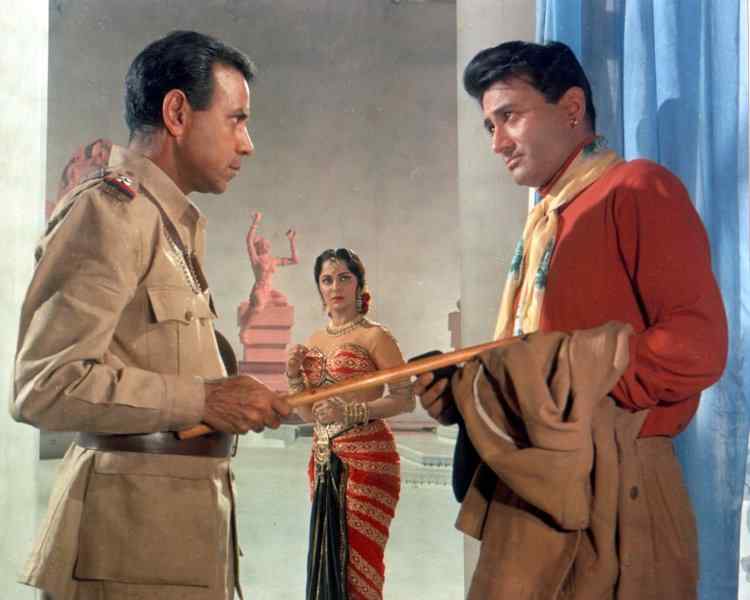
Image: Film Guide. Image courtesy: SUBHASH CHEDA
Talking about her role as Rosie, the dancer who leaves her chauvinistic, archeologist husband’s home to take refuge in a humble tourist guide’s poor dwelling, Waheeda Rehman states that her role was even more complex than that of the guide. “It was unheard of for a leading lady to be already married in the first frame of a film. And then, for her and the guide to live together was very bold and far ahead of the times. But it is to Vijay Anand’s credit that the relationship did not come across as cheap. Rather, it had a lot of dignity in it. It was a great subject because a great writer wrote it. The characterization was detailed and the emotional graph very natural. I got a chance to express a range of emotions. In fact, all the three central characters were very rounded with shades of both good and bad.”[iv]
When she walks out of the marriage with Raju, the guide, her adulterous relationship is glossed over and kept invisible because Raju for Rosie, is just a gateway, a 'guide' to artistic freedom and autonomous self-expression. They lose interest in each other once she attains fame and money while Raju is happy in the lap of luxury, basking in her reflected glory. Between the two of them, it is Raju who feels more emotionally insecure about the relationship because Rosie is married to another, he is not. Rosie and Marco never get down to divorcing each other.
The theme of Rosie’s rise and Raju’s fall is conveyed as a question of the knowledge of the Self and of each other, which eludes the central characters. Both adopt different roles – Rosie the dancer assumes the public persona of Nalini while Raju switches from guide to managing agent for Rosie. But the two fail to adjust to this change in the public images that go with their changed roles. The irony is that Rosie attains her dreams of being an acclaimed dancer but is no longer able to feel emotion, while Raju attains the good life at the cost of Rosie for whom he had assumed the new role to begin with.[v]
For Rosie, dance is a spontaneous expression of pure ecstasy as the snake charmer dance number reveals so beautifully. The trance-like state in the end when she falls into a faint does not appear either melodramatic or artificial. It is inserted at the right time and place and in the situation appropriate to reveal a not very well-known facet of Rosie’s character, as much to the audience in the theatre as to Raju who is the audience-within-the-film.
The universality of dance in Rosie’s mindset is explored when Rosie asks Raju to take her to a sapere-ke-basti – a cluster inhabited by snake charmers only – instead of allowing him to show her the sights in and around Udaipur as Marco had instructed. It does not matter to her that her presence in a snake charmers’ colony would be both incredible and incongruous. Nor does she plan the visit with the purpose of performing. As she watches a gypsy woman perform, she joins the dance spontaneously and gets totally absorbed into it and by it, erasing completely, the world around her at that point. While they drive back to the hotel, she suggests that Raju should not mention the incident to Marco. Note that the dance has no song but only the been of the snake charmer, an original and creative marking point in Indian cinema. Rosie’s dance in the snake-charmers' basti is one of the most sensuous and graceful dances ever seen on the Indian screen. Hitching up her sari, Rosie is mesmerised into the dance, swaying away like a woman possessed, her movements graceful and lyrical like the lines of a poem, with only the snake charmer’s been and the drums offering her company. This sequence clearly spells out the essence of Rosie's life.
Waheeda Rehman’s talents as a dancer were fully exploited in Guide by choreographers Hiralal and Sohanlal. When she breaks into a dance after escaping the claustrophobic environment of her husband’s home, the choreography matching Shailendra’s lyrics – Kaanto Se Kheechke Yeh Aanchal is the next song-dance number performed by Rosie. It conveys all the exhilaration of a free soul and is one of the turning points of the film. The famous low angle tracking shot of Waheeda dancing along the ledge of the temple continues to amaze one even today. The song was shot in Udaipur and conveyed the exact feeling of a woman coming out of a cage,” recalls Waheeda.
Though Guide focuses on the metamorphosis of Raju, the guide, the narrative and cinematic space gives almost equal importance to Rosie. Thus, there is a democratic ordering of space though the director, Vijay Anand, is a man. But can Rosie's affair truly be called adulterous? Wasn't her marriage to Marco a still-born one in every sense of the term except for the economic support it offered Rosie? Did it, as her mother promised, liberate her from the stigma of being born into a devadasi family? The answer is: did Rosie want to be liberated from her dancing which only her devadasi background could have given her? Her dance proves that the gift she was born with was something she could never run away from. Raju, the guide just gave her the gentle push Marco refused to offer. Her love for dancing was stronger than her love for Raju. But if this be true, then what brought Rosie to her guide when he was dying, miles away from her world? The film leaves the question unanswered, throwing it at the audience to draw its own conclusions. But it reiterates the functioning of Rosie as a woman who uses an alternative voice, her dance - to communicate with, an original political strategy she might not have been aware of, but which nevertheless gave her short phases of happiness and fulfillment in her tragic life.
***
[i]Cooper, Darius: In Black and White – Hollywood and the Melodrama of Guru Dutt, Seagull Books, Calcutta, 2005, pp.53-54.
iiIbid.pp.55-56.
[ii]i Ibid.42-43.
[iv] Choudhary, Alpana: Dev Anand: Dashing Debonair, Charitabali Series, Rupa Books, New Delhi, pp.66-67.
[v] Chakravarty, Sumita S.: National Identity in Indian Popular Cinema, 1947-1987; OUP, 1996, p.50.
What's Your Reaction?









































